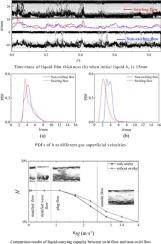Experimental Thermal and Fluid Science ( IF 2.8 ) Pub Date : 2021-07-16 , DOI: 10.1016/j.expthermflusci.2021.110479 Wen Liu 1 , Sheng Jiang 1 , Huazheng Li 1

|
In natural gas pipelines, temperature and pressure vary along the line, leading to liquid condensation in undulating sections of the pipelines. This phenomenon has a significant impact on the gas transportation efficiency and safety. In this study, an experimental investigation on liquid-carrying by a swirling flow in an undulating pipeline was carried out. As the condensate liquid would usually accumulate in the pipeline, a U-shaped tube with a diameter of 0.025 m was used to simulate a low-lying part. The effect of swirl on flow patterns in the U-shaped tube was observed using a high-speed camera and processed with image processing technology. Five flow patterns, namely stratified, stratified wave, slug, plug and annular flow, were observed in the U-shaped tube under gas superficial velocities ranging from 0.17 to 14.15 m/s, and with the height of liquid accumulation ranging from 15 to 125 mm. Compared to a non-swirling flow, the swirling flow was observed to increase the liquid-carrying capacity; which however, was a function of the flow pattern. The liquid-carrying capacity of the swirling flow for different flow patterns in the order of highest to lowest was: annular, slug, plug, stratified wave and stratified flow. The initial liquid volume and inlet gas velocity also influenced the liquid-carrying efficiency of the swirling flow. With an increasing gas flow rate, the fluctuation of gas–liquid interface increased, and the liquid-carrying efficiency also increased. Furthermore, Swirling flow reduced the critical gas velocity needed to carry the liquid phase by 14.14% compared to a non-swirling flow.
中文翻译:

U型管涡流载液实验研究
在天然气管道中,温度和压力沿线变化,导致管道起伏段的液体冷凝。这种现象对气体输送的效率和安全有很大的影响。在这项研究中,对波状管道中的涡流携带液体进行了实验研究。由于冷凝液通常会积聚在管道中,因此采用直径为0.025 m的U形管模拟低洼部位。使用高速相机观察旋流对 U 形管中流动模式的影响,并使用图像处理技术进行处理。在 0.17~14.15 m/s 的气体表观速度下,在 U 形管中观察到分层、分层波、段塞、塞和环流五种流动模式,并且积液高度从15到125mm不等。与非旋流相比,观察到旋流增加了液体承载能力;然而,这是流动模式的函数。不同流型下旋流的携液能力从高到低依次为:环流、段塞、塞流、层流、层流。初始液体体积和入口气体速度也影响旋流的携液效率。随着气体流量的增加,气液界面的波动增加,携液效率也增加。此外,与非旋流相比,旋流将携带液相所需的临界气体速度降低了 14.14%。与非旋流相比,观察到旋流增加了液体承载能力;然而,这是流动模式的函数。不同流型下旋流的携液能力从高到低依次为:环流、段塞、塞流、层流、层流。初始液体体积和入口气体速度也影响旋流的携液效率。随着气体流量的增加,气液界面的波动增加,携液效率也增加。此外,与非旋流相比,旋流将携带液相所需的临界气体速度降低了 14.14%。与非旋流相比,观察到旋流增加了液体承载能力;然而,这是流动模式的函数。不同流型下旋流的携液能力从高到低依次为:环流、段塞、塞流、层流、层流。初始液体体积和入口气体速度也影响旋流的携液效率。随着气体流量的增加,气液界面的波动增加,携液效率也增加。此外,与非旋流相比,旋流将携带液相所需的临界气体速度降低了 14.14%。是流动模式的函数。不同流型下旋流的携液能力从高到低依次为:环流、段塞、塞流、层流、层流。初始液体体积和入口气体速度也影响旋流的携液效率。随着气体流量的增加,气液界面的波动增加,携液效率也增加。此外,与非旋流相比,旋流将携带液相所需的临界气体速度降低了 14.14%。是流动模式的函数。不同流型下旋流的携液能力从高到低依次为:环流、段塞、塞流、层流、层流。初始液体体积和入口气体速度也影响旋流的携液效率。随着气体流量的增加,气液界面的波动增加,携液效率也增加。此外,与非旋流相比,旋流将携带液相所需的临界气体速度降低了 14.14%。初始液体体积和入口气体速度也影响旋流的携液效率。随着气体流量的增加,气液界面的波动增加,携液效率也增加。此外,与非旋流相比,旋流将携带液相所需的临界气体速度降低了 14.14%。初始液体体积和入口气体速度也影响旋流的携液效率。随着气体流量的增加,气液界面的波动增加,携液效率也增加。此外,与非旋流相比,旋流将携带液相所需的临界气体速度降低了 14.14%。











































 京公网安备 11010802027423号
京公网安备 11010802027423号